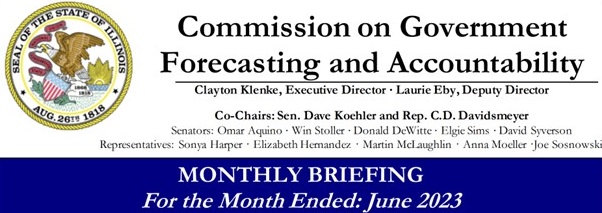The recently-concluded fiscal year, which ended June 30, 2023, saw a wind-down of the unusual budget situation that accompanied the COVID-19 pandemic and its aftermath. The pandemic had a devastating effect on many Illinois economic sectors and workers in 2020. Then, a massive outburst of government stimulus spending, underwritten by the federal government, created new money velocity associated with rapidly rising inflation. During this period Illinois was getting more money from the federal government and was simultaneously getting more money from general revenue tax flows tied to price levels and inflation, such as the State sales tax. In association with these two trends, in FY22 Illinois actually ran a general-funds budget surplus – the first time this had happened in decades.
The numbers generated by CGFA, the General Assembly’s budget monitoring arm, for FY23, show that this unusual event could not be sustained. During the final months of FY23, including June 2023, State general funds receipts fell short of those that had been posted in comparable months of FY22 on a year-over-year basis. This shortfall in State income and sales tax receipts came despite the continued presence of significant inflation in employee payrolls, retail stores, utility bills, and at the gas pump.
For the State of Illinois as a whole, FY23 general funds receipts totaled more than $53.1 billion in FY23, the year that ended June 30, 2023. While this was an increase of $2.1 billion over the figure of more than $51.0 billion for FY22, virtually all of this increase was attributable to one-time transfers of funds. $2.4 billion in net increases of FY23 receipts over comparable FY22 figures were credited to the net effects of funds transferred in, including former COVID-19 aid funds transferred from the State’s CURE fund into General Revenue. On Wednesday, July 5, CGFA staff published a warning to the General Assembly that this upward-seeming FY23 fiscal picture should be attributed to “federal dollars” and should not be treated as a sustainable State cash flow of spendable money. As FY23 came to an end, underlying State of Illinois base tax revenues were actually falling, not rising. This included the key revenue cash flow represented by income taxes and sales taxes.
